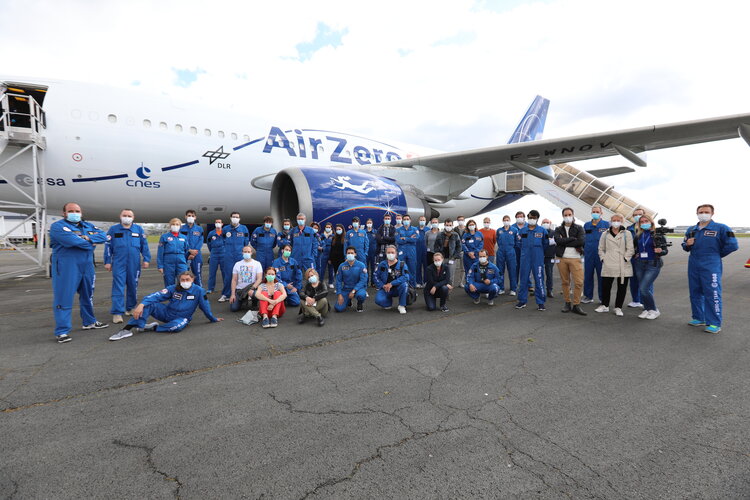Researchers take a group photo in front of the Air Zero G aircraft to mark the end of the 75th ESA parabolic flight campaign. The campaign was the third to take place under Covid-19 restrictions, and ran from 21 to 30 April in Bordeaux, France.
Participants and coordinators adjusted to a new way of flying: PCR tests were required to enter France, as well as rapid antigen or RT LAMP tests each day for every participant. Facilities on the ground as well as on board were adapted to allow for social distancing and cleanliness requirements. Surgical masks were worn at all times, and movement was restricted during the flights.
Otherwise, the parabolic flights were business-as-usual. Teams from various research institutes and universities performed experiments and technology demonstrations across many disciplines including complex fluidics, astronomical light scattering, protoplanetary agglomeration, and human physiology in altered states of gravity.
Initially used for training astronauts, parabolic flights are now mostly used for short-duration scientific and technological investigations in reduced gravity. These flights are the only way for humans to run tests in microgravity without going through lengthy astronaut-training and flights to the International Space Station.
To perform each parabola, the refitted A310 Air Zero G aircraft flies close to maximum speed and pulls the nose up to a 45° angle, then cuts the power to fall over the top of the curve. Whilst falling freely the passengers and experiments experience around 20 seconds of microgravity, until the plane is angled 45° nose-down, before pulling out of the dive to level off with normal flight.
These “pull up” and “pull out” manoeuvres before and after the weightless period increase gravity inside the plane up to 2g, but that is just part of the ride, repeated every three minutes for almost two hours.
A typical parabolic flight campaign involves three flights and requires a week of on-site preparation. Each flight offers 31 periods of weightlessness. The aircraft can also fly in arcs that provide lunar or martian gravity levels by adjusting the angle of attack of the wings.
Simplicity of preparation and operations, reduced cost, partial-gravity levels, multiple microgravity phases and opportunity for researchers to work directly on the experiments on board are some of the unique advantages..
Parabolic flights are organised by Novespace, which handles flight and ground operations. ESA, French space agency CNES, and German space agency DLR are the promoters and sponsors of the programme.



 Image:
Image: